The Great Gestalt Rescue (TA Interview Presentation)
Table of Contents
ABOUT:
The Great Gestalt Rescue is the presentation I gave for my PSYCH 1X03/1XX3 TA interview. The instructions were to prepare a “10 minute MacIntroPsych lesson with PowerPoint slides” on any topic from first year psychology. I decided to prepare my presentation on the Gestalt Principles, a set of laws of human perception that explain how people group, simplify, and perceive objects in the world around them. As a graphic designer in my downtime, this psychology topic was an obvious choice for me! I decided to frame the lesson as a Mario adventure…a fun and perhaps unexpected way of teaching.
- I Learned How To: teach with delight (the art historian Gustav Friedrich Waagen once said “First delight, then instruct."), be interviewed, and I also learned a lot of new things about the Gestalt Principles myself!
- Next I Want To: pass on my passion for psychology onto the new generation of first-year students (Hint: I got the job. 😉).
🗺️ I. The Great Gestalt Rescue
To start off, I want you to meet my friend Mario!

Actually, Mario has a bit of a problem on his hands. Here’s the situation: Mario’s brother, Luigi, has been mysteriously kidnapped…oh no!

To rescue his brother, Mario needs to travel through the treacherous lands of Mario’s World. This world is very complex. Mario has a million things to keep track of inside Mario’s world…
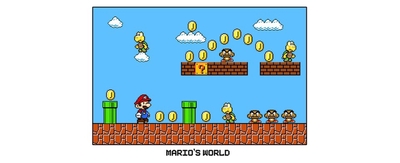
Since Mario’s World is full of complicated (and sometimes even dangerous) things, Mario needs to recognize and make sense of the things he sees very quickly.
Luckily, Mario has 6 superpowers to help keep him safe. His superpowers are collectively called The Gestalt Principles, and there are 6 principles in total. Each principle gives a different superpower of form perception, so that he can simplify, organize and understand the complex forms of the objects he sees in the world.

So let’s enter Mario’s world together and see how Mario uses the Gestalt Principles to navigate enemy territory and rescue Luigi!
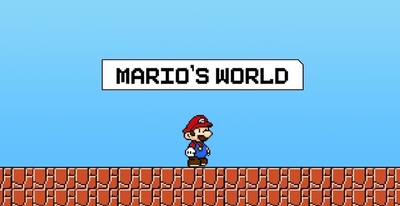
I. Figure-Ground Separation
First up, Mario needs a power up! Luckily, Mario knows exactly how to find himself a super mushroom to make him stronger. Using the principle of Figure-Ground Separation, Mario can distinguish objects from the background. He is able to see “object-like” features in forms that are supposed to be objects. For example, the super mushroom has black borders and other colour patterns that make it distinct from the sky. Figure-Group Separation allows Mario to view objects as separate from the background, which is one way he can see depth.
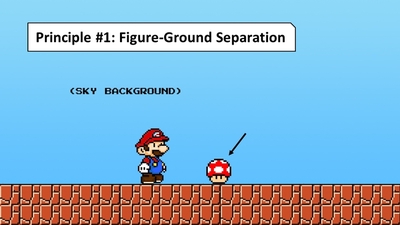
II. Proximity
Next, it was a good thing Mario got a power up first, because it looks like trouble is coming! He sees some evil Goomba creatures, and there are too many to keep track of! But don’t worry, Mario can use the Gestalt Principle of Proximity to help him. When objects are not evenly spread out, and instead are packed more closely in some places, they are easily grouped together. So Mario groups the Goomba in front of him as one enemy group and the Goomba on top of the bricks as another enemy group. Now he knows there are 2 main groups of enemies to fight, which is much better than 5. Proximity principle helps Mario simplify any stimuli that are overwhelming in number. Now that’s a good strategy!
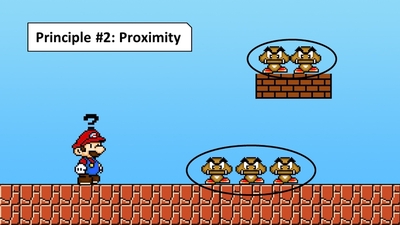
III. Continuity
As Mario continues his journey, he gets a little distracted…by gold! There seem to be lots of coins for him to grab, but he wants to do this in the most efficient way possible so he can get back to rescuing Luigi. By following the Gestalt Principle of Continuity, he knows that instead of following this path…
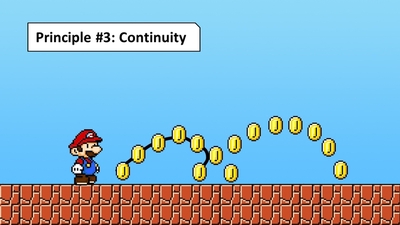
…which is a very awkward line with strange angles, he should follow this path:
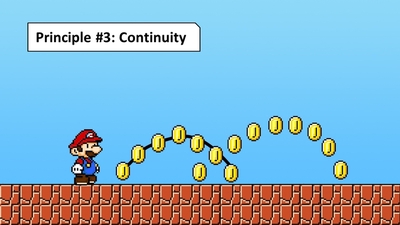
…which is made of a nice nice continuous line that is very simple and doesn’t have awkward angles. Continuity principle allows Mario to see simple forms instead of complicated ones. This is important because it allows him to understand complex, overlapping forms more easily.
IV. Common Fate
Now a rich man, Mario returns to his rescue mission. Unluckily, there are more enemies waiting for him! This time, the enemy is even camouflaged, the green leaves of the piranha plant blend with the green colour of the pipe. Fortunately, the Gestalt Principle of Common Fate tells Mario that objects that move together should be grouped together. In this case, Mario can see that the piranha plant moves up and down whereas the pipe remains still. The contrast between the still pipe and moving plant makes the plant distinct! Common Fate principle groups objects that move in together in the same direction or at the same time. This way, these objects can be identified as separate.
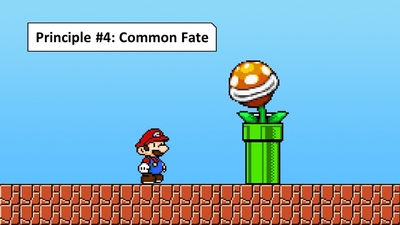
V. Similarity
With another enemy creature defeated, Mario returns to his mission. He comes across some interesting blocks. But how does he know which blocks are important? He uses the Gestalt Principle of Similarity to group together objects that are similar in some way. For example, the yellow blocks are different from these brown blocks by colour and pattern, so Mario knows to group them together. By using Similarity principle, Mario can group objects by colour, pattern, size, orientation, shape, or any other characteristic you can think of. And after checking out these mystery blocks Mario’s has grouped together, it seems like Mario has become an even richer man, and also found a key!
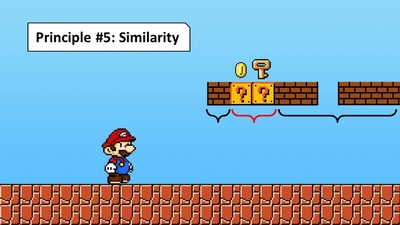
VI. Closure
Armed with a key, Mario marches onward…and look! It looks like he’s found a mysterious door. Could this be where Luigi is trapped? To find out, he needs to insert the key on top of the door. How does he know this you ask? Well, Mario uses the Gestalt Principle of Closure to see that the black dots above the door are not just random individual dots. He fills in the spaces between the dots to perceive the shape of a key! The Closure principle helps him fill in the gaps in his visual knowledge so he can make sense of what he sees even when he’s missing information.
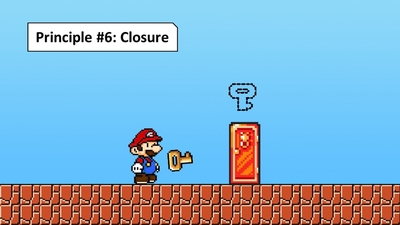
So with this in mind, Mario inserts the key above the door…
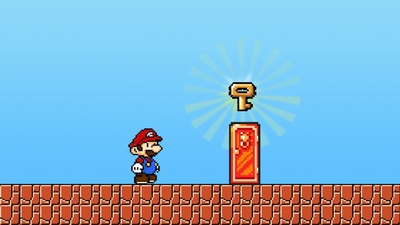
and he and Luigi are happily reunited! Woohoo!
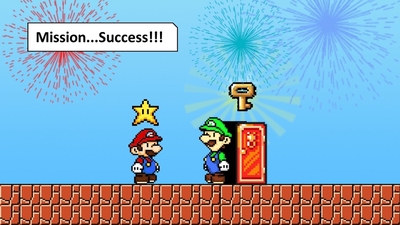
🚀️ II. Beyond Mario’s World…
Up until now, we’ve been following how Mario uses the Gestalt Principles to navigate HIS complex universe. But it turns out Mario is not the only one with these superpowers.
In fact, if we leave Mario’s world, you will see that the Gestalt Principles are your superpowers too!
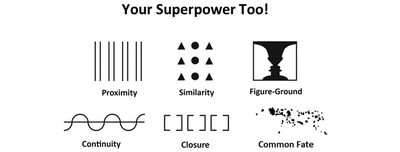
These Gestalt Principles of Proximity, Similarity, Figure-Ground Separation, Continuity, Closure and Common Fate are rules that our brains naturally use to organize information. So now we know what the Gestalt Principles are and how they help us organize the world we see.
But why is it important for us to organize visual input in the first place? Well, compared to Mario’s World, our world is even more complicated. For instance, here’s an example from our world.
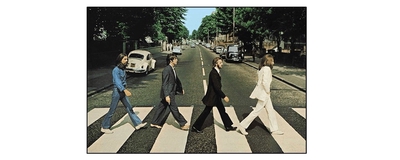
You all might’ve seen this famous Beatles album cover once or twice, or maybe closer to a million times.
What you might have not noticed is that there is actually a LOT going on in this photo: cars, trees, buildings, people. And if you think about it, all this visual input we see is actually just billions of dots in patterns.
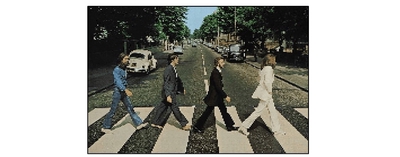
Creating forms from all the complicated dots that we see would normally be difficult and overwhelming.
But because we can easily organize these dots, none of us think that this picture is difficult to interpret. We use Similarity principle to group the cars together by function. Figure-Ground Separation tells us that the trees are part of the background. And although the crosswalk is missing lines that go all the way from left to right, we can fill in empty space to understand where the crosswalk should be so we know the Beatles are not jaywalking.

All of this helps us better perceive and understand the world around us! And amazingly, we apply all these Gestalt Principles automatically, we don’t even think about it!
Moving beyond the automatic individual level, many industries deliberately use Gestalt Principles to make better designs and decisions. Here are just a few examples…
- The World Wildlife Fund logo would not be the same without Closure principle.
- Figure-Ground Separation makes the fascinating Human Pillar Illusion work.
- And Gestalt Principles even find their impact on the things like the Connect4 Games of our youth.
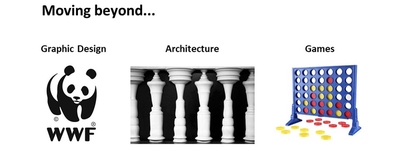
So whether you are Mario getting rich in Mario’s World or crossing Abbey Road in our world, the Gestalt Principles will help you organize and understand the amazing things in the universe around you.

Thank you for joining us on the Great Gestalt Rescue! I hope you enjoyed adventuring with Mario and learned a little introductory psychology on the way! Until next time!